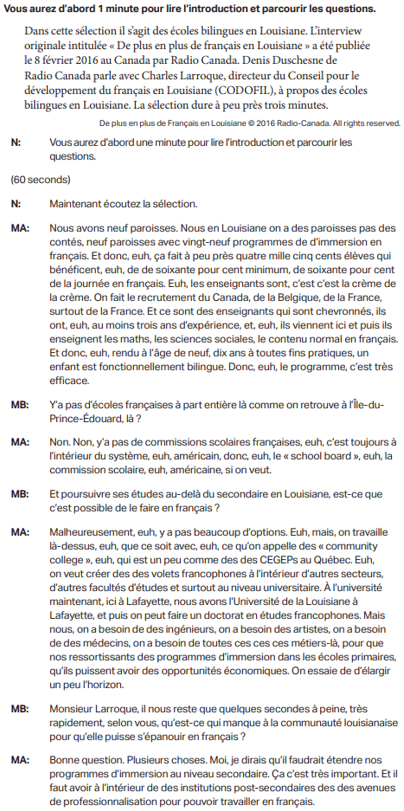Ultimate Guide to the AP French Language and Culture Exam
The AP French Language and Culture exam is one of the most popular AP language exams, second only to Spanish. In 2019, over 23,000 students took the exam—about 75% of which were standard foreign language students, with the remainder being students who regularly spoke or heard the foreign language outside of school, or who studied abroad for more than one month. Students who are interested in gaining proficiencies in the interpersonal, interpretive, and presentational modes of French communication are best suited for this line of study. If you are interested in taking the AP French Language and Culture exam—whether you have taken the class, are a native-speaker, or have self-studied—read on for a breakdown of the test and CollegeVine’s advice for how to best prepare for it. On Friday, May 15, at 8 am, the College Board will administer the 2020 AP French Language and Culture exam. For a comprehensive AP exam schedule, along with study tips and more, check out our blog post 2020 AP Exam Schedule: Everything You Need to Know. The AP French Language and Culture exam aims to promote both fluency and accuracy in French language use. To accomplish this, the AP French Language and Culture course is taught primarily in French, and students will read and listen to authentic texts from the francophone world throughout the course. The course focuses on the three foundational modes of communication as defined in the Standards for Foreign Language Learning in the 21st Century: Interpersonal, Interpretive, and Presentational. Though it is easy to get caught up in grammatical nuances when learning a foreign language, the AP curriculum explicitly seeks not to overemphasize grammatical accuracy at the expense of communication. As such, while grammar is tested on the exam in the context of written and oral responses, a higher weight is placed on general communication skills. A spelling reform known as La Nouvelle Orthographe is currently underway in France. The new spelling is officially encouraged but not required by the French government. The AP French Development Committee notes that students will not be penalized for using the new spellings in the writing portion of the AP French Language and Culture exam. AP French Language and Culture Course Content There are no formal prerequisites for the AP French Language and Culture course; however, most students who take it are in their fourth year of high school-level French study. Native speakers or students with exceptional exposure to the French language may take a different course of study leading to the AP French Language and Culture course, or might completely self-study for the exam. The framework of the AP French Language and Culture course is made up of six units, and contained within those six units are five to seven contexts. Through the exploration of these units and their contexts, you’ll gain a deeper understanding of French language and culture and engage with it in a variety of ways. Below are the six units and their contexts: Throughout the AP French Language and Culture course, you’ll develop and hone eight language and communication skills. Below is a list of the eight course skills, a description of each, and the weight given to each skill on the multiple-choice section of the AP French Language and Culture exam: multiple-choice section. multiple-choice section. multiple-choice section. multiple-choice section. The AP French Language and Culture exam is one of the longer exams, consisting of two sections, and clocking in at three hours and three minutes. The first section takes one hour and 35 minutes to complete, contains 65 multiple-choice questions, and accounts for 50% of your total score. The multiple-choice section of the AP French Language and Culture exam is two parts. In the first part, you will spend 40 minutes completing 30 multiple-choice questions based on printed texts. In the second part, you will have 55 minutes to complete 35 multiple-choice questions based on audio or combination audio and print texts. Section 1(a): Multiple-Choice Text 40 minutes | 30 questions | 23% of score The first multiple-choice section of the exam uses print materials—such as journalistic and literary texts, announcements, advertisements, letters, charts, maps, and tables—as a stimulus. The questions require you determine the main idea and details of the stimulus, determine the meaning of words in context, identify the author’s point of view or target audience, and demonstrate cultural knowledge or interdisciplinary information contained in the stimulus. Examples of text-based multiple-choice questions: Answers – 1: C | 2: B | 3: D Section 1(b): Multiple-Choice Audio 55 minutes | 35 questions | 27% of score The second part of the multiple-choice section uses audio material—interviews, podcasts, PSAs, conversations, and brief presentations—as a stimulus. In this part of the exam, students will encounter two subsections of questions. One set of questions uses audio files in combination with print materials as the stimulus, and the other set of questions uses only audio material as the stimulus. Examples of audio-based multiple-choice questions (click on the question for audio): Answers – 12: B | 13: D The free response section of the AP French Language and Culture exam is also broken down into two parts. The first part of the free response section is focused on writing, the other part is centered on speaking. Section 2(a): Free Response Written 1 hour 10 minutes | 2 questions | 25% of score The first part of the free response questions consists of two questions. The first question requires you to read and reply to an email. You’re alloted 15 minutes to answer this question and it accounts for 12.5% of your total score. The second question tasks you with writing an argumentative essay based on three provided sources. You’re given 55 total minutes—15 to review sources and 40 minutes to write—to form your essay. This question also accounts for 12.5% of your exam score. Example of an email free response question: Section 2(b): Free Response Spoken 18 minutes | 2 questions | 25% of score During the second part of the free response section, you will listen and respond orally to prompts. You will first need to complete five exchanges (20-second responses) in a simulated conversation. You will then deliver a 2-minute presentation comparing a cultural feature of a French-speaking community to another community you’re familiar with. Example of a spoken free response question: In 2019, students generally did quite well on the AP French Language and Culture exam. Of all test takers, more than 77% received a score of 3 or higher, including 73.9% of standard group students (excluding native or heritage speakers). Only 16.1% of all students received the top score of 5, while less than 5% scored a 1 on the exam. Keep in mind that credit and advanced standing based on AP scores varies widely from college to college. While a 3 is generally considered passing, you may need a 4 or 5 to receive credit. Some schools don’t grant credit at all, and only use AP exams for placement. You can find regulations regarding which AP exams qualify for course credits or advanced placement at specific colleges on the College Board’s website. A full course description that can help to guide your studying and understanding of the knowledge required for the test can be found on the College Board AP French course website. If you’re curious about other score distributions, see our post Easiest and Hardest AP Exams. Take a practice test to assess your initial knowledge of the material. Although the College Board does not provide a complete practice test, you can find sample questions with scoring explanations included in the course description. Additionally, there are free practice exam questions available on practiceexam.com. You may also find practice or diagnostic exams in many of the commercial study guides. To really devote yourself to this study, you should endeavor to immerse yourself as much as possible in French language and culture. You should listen to, speak, and read French as much as you can. You can find interesting books in French, watch Youtube videos in French, read the French news (like Le Monde), follow French blogs, or listen to French podcasts. Try to find engaging sources of information presented in French and use them as much as possible. You will be amazed by how much your own listening, spoken language, and written French will improve simply from exposing yourself to the language more often. You can also prepare for the exam by reviewing the College Board’s AP World Language Practice Tips and by previewing the exam’s sample AP French audio files. For a more specific idea of where to focus your studying, you may consider using a commercial study guide. Barron’s AP French Language and Culture with MP3 CD offers a comprehensive guide to the exam content, including two full-length practice exams with all questions answered and explained, along with an MP3 CD containing exemplary conversations and oral presentations. Barron’s is the top-rated choice for AP French Language and Culture study guides. Another solid option is the AP French Language & Culture All Access w/Audio: Book + Online + Mobile, which receives good reviews for the volume of practice material it includes, though some users note that it contains some typos and should be used only in conjunction with other study materials to reinforce existing skills. In addition, there are tons of study resources available online, including many from AP teachers who have posted comprehensive outlines and study guides. This AP French website, created by a long-time teacher, has a host of links, references, and courses. Best of all, it’s free! Another convenient way to study is to use one of the recently-developed apps for AP exams.. The FluentU app has a free version with basic video content that is highly rated for foreign language acquisition, but watch out for in-app purchases—the “Plus” version can set you back between $30 and $240. Once you have your theory down, test it out by practicing multiple-choice questions. You can find these in most study guides or through online searches. You could also try taking the multiple-choice section of another practice exam. The College Board Course Description includes many practice multiple choice questions along with explanations of their answers. As you go through these, try to keep track of which areas are still tripping you up, and go back over this theory again. Focus on understanding what each question is asking and keep a running list of any vocabulary that is still unfamiliar. Your preparations for the free response section of the AP French Language and Culture exam will differ from the preparations for those of other AP exams. Although you’ll still need to practice some writing responses, you’ll also need to practice your listening skills and oral responses. Regardless, you should begin your preparations for the free response section by brushing up on your vocabulary and grammar. Quizlet and Brainscape both have good online flashcards available for free. Make sure you have a solid selection of verbs to fall back on in both conversational and formal tones, and practice using them in multiple contexts. Although you won’t officially be scored on your grammar, you’ll still need to be able to communicate effectively, so make sure you can get your point across. Your best preparation for the written prompts is simple: repeated practice prompts. You can find tons of past exam prompts dating back to 2012 on the College Board’s AP French Language and Culture exam homepage. While you’re there, also check out the Student Performance Q&A links, which give you insights from the Chief Reader of the AP Exam. This figure compiles feedback from members of the reading leadership to describe how students performed on the free response questions, summarize typical student errors, and address specific concepts with which students have struggled the most that particular year. The oral portion of the free response section is perhaps the hardest to prepare for, since it can be difficult to gauge your own speaking abilities. One suggested practice method is to record your own sample answers using the past exam prompts, and then replay them for yourself after you’ve reviewed the scoring criteria. You might also team up with a classmate to compare responses and offer each other some constructive criticism. Another less direct method of preparation is simply to make sure you are hearing and speaking as much French as possible on a daily basis. As you did at the very beginning of your studying, take a practice test to evaluate your progress. You should see a steady progression of knowledge you’ve accumulated, and it’s likely that you will see patterns identifying which areas have improved the most and which areas still need improvement. If you have time, repeat each of the steps above to incrementally increase your score. If you’re taking the AP course associated with this exam, your teacher will walk you through how to register. If you’re self-studying, check out our blog post How to Self-Register for AP Exams. For information about what to bring to the exam, see our post What Should I Bring to My AP Exam (And What Should I Definitely Leave at Home)? Want access to expert college guidance — for free? When you create your free CollegeVine account, you will find out your real admissions chances, build a best-fit school list, learn how to improve your profile, and get your questions answered by experts and peers—all for free. Sign up for your CollegeVine account today to get a boost on your college journey. For more information about APs, check out these CollegeVine posts: When is the AP French Language and Culture Exam?
About the AP French Language and Culture Exam
Unit
Contexts
Families and Communities
Personal and Public Identities
Beauty and Aesthetics
Science and Technology
Contemporary Life
Global Challenges
Course Skill
Description
Percentage of Exam Score (Multiple-Choice Section)
Comprehend Text
Comprehend written, audio, audiovisual, and visual text (text, pictures, and numbers).
20%-30%
Make Connections
Make interdisciplinary and cultural connections.
30%-40%
Interpret Text
Interpret the content of written or audio text (words).
30%-40%
Make Meanings
Make meanings from words and expressions.
10%-15%
Speak to Others
Communicate interpersonally by speaking with others.
Not directly assessed in the
Write to Others
Communicate interpersonally by writing to others.
Not directly assessed in the
Present Orally
Communicate through spoken presentations.
Not directly assessed in the
Present in Writing
Communicate through written presentations.
Not directly assessed in the
AP French Language and Culture Exam Content
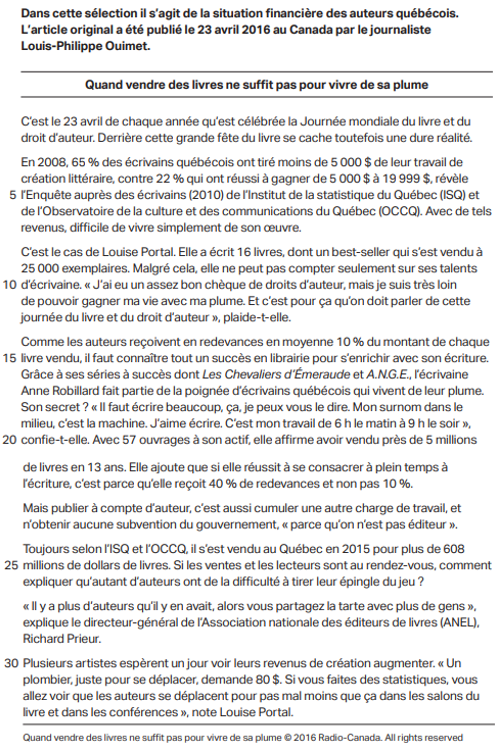
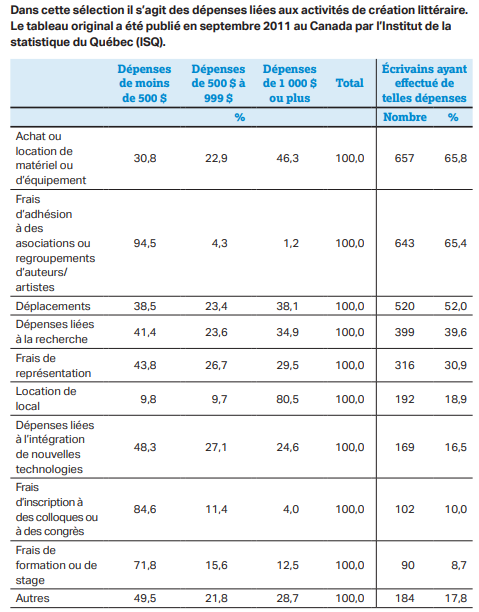
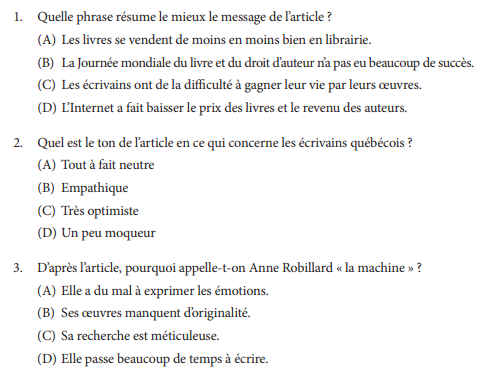
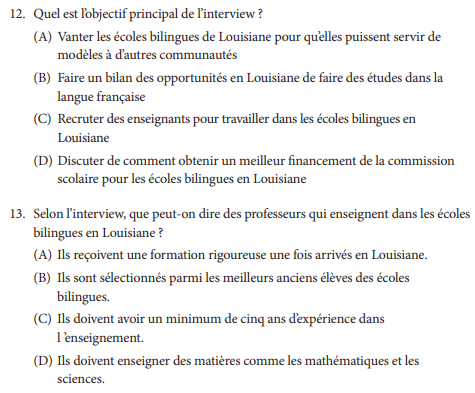
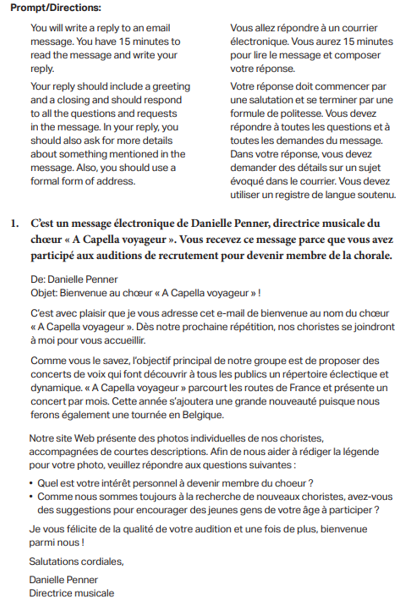
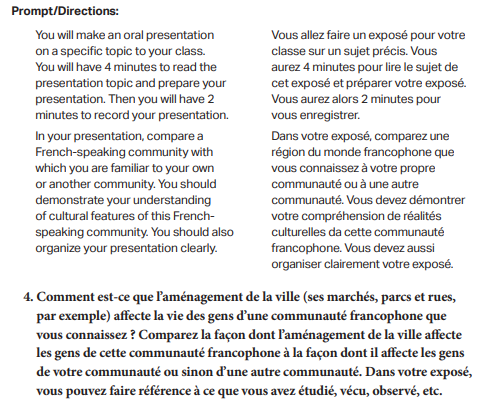
AP French Language and Culture Score Distribution, Average Score, and Passing Rate
Exam
5
4
3
2
1
AP French Language and Culture
16.1%
25.3%
35.7%
18.2%
4.7%
Best Ways to Study for the AP French Language and Culture Exam
Step 1: Assess Your Skills
Step 2: Study the Theory
Step 3: Practice Multiple-Choice Questions
Step 4: Practice Free Response Questions
Step 5: Take Another Practice Test
Step 6: Exam Day Specifics
